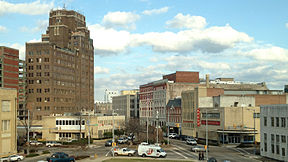
Back ميريديان (مسيسيبي) Arabic ميريديان (ميسيسيبى) ARZ مریدیان، میسیسیپی AZB মেরিডিয়ান, মিসিসিপি Bengali/Bangla Meridian (Mississipi) Catalan Меридиан (Миссисипи) CE Meridian (kapital sa kondado sa Tinipong Bansa, Mississippi) CEB مێریدیان CKB Meridian, Mississippi Welsh Meridian DAG
Meridian, Mississippi | |
|---|---|
A view of downtown from the third floor of Meridian City Hall; the 16-story Threefoot Building dominates the skyline | |
| Nickname: Queen City | |
| Motto: "A Better Longitude On Life" | |
 Location of Meridian in Lauderdale County | |
| Coordinates: 32°22′29″N 88°42′15″W / 32.37472°N 88.70417°W | |
| Country | United States |
| State | Mississippi |
| County | Lauderdale |
| Incorporated | February 10, 1860 |
| Government | |
| • Type | Mayor-council government |
| • Mayor | Jimmie Smith (D) |
| Area | |
• City | 54.51 sq mi (141.17 km2) |
| • Land | 53.74 sq mi (139.19 km2) |
| • Water | 0.76 sq mi (1.98 km2) |
| Elevation | 344 ft (105 m) |
| Population (2020) | |
• City | 35,052 |
| • Density | 652.24/sq mi (251.83/km2) |
| • Metro | 107,449 |
| Time zone | UTC−6 (CST) |
| • Summer (DST) | UTC−5 (CDT) |
| ZIP code(s) | 39301-39307 |
| Area code | 601 |
| FIPS code | 28-46640 |
| GNIS feature ID | 0673491 |
| Website | www |
Meridian is the eighth most populous city in the U.S. state of Mississippi,[2] with a population of 35,052 at the 2020 census.[3] It is the county seat of Lauderdale County and the principal city of the Meridian, Mississippi Micropolitan Statistical Area. Along major highways, the city is 93 mi (150 km) east of Jackson; 154 mi (248 km) southwest of Birmingham, Alabama; 202 mi (325 km) northeast of New Orleans, Louisiana; and 231 mi (372 km) southeast of Memphis, Tennessee.
Established in 1860, at the junction of the Mobile and Ohio Railroad and Southern Railway of Mississippi, Meridian built an economy based on the railways and goods transported on them, and it became a strategic trading center. During the Civil War, General William Tecumseh Sherman burned much of the city to the ground in the Battle of Meridian (February 1864). Rebuilt after the war, the city entered a "Golden Age". It became the largest city in Mississippi between 1890 and 1930, and a leading center for manufacturing in the South, with 44 trains arriving and departing daily. Union Station, built in 1906, is now a multi-modal center, with access to Amtrak and Greyhound Buses averaging 242,360 passengers per year. Although the economy slowed with the decline of the railroad industry, the city has diversified, with healthcare, military, and manufacturing employing the most people in 2010. The population within the city limits, according to 2008 census estimates, is 38,232, but a population of 232,900 in a 45-mile (72 km) radius and 526,500 in a 65-mile (105 km) radius, of which 104,600 and 234,200 people respectively are in the labor force, feeds the economy of the city.
The area is served by two military facilities, Naval Air Station Meridian and Key Field, which employ over 4,000 people. NAS Meridian is home to the Regional Counter-Drug Training Academy (RCTA) and the first local Department of Homeland Security in the state. Students in Training Air Wing ONE (Strike Flight Training) train in the T-45C Goshawk training jet. Key Field is named after brothers Fred and Al Key, who set a world endurance flight record in 1935. The field is now home to the 186th Air Refueling Wing of the Air National Guard and a support facility for the 185th Aviation Brigade of the Army National Guard. Rush Foundation Hospital is the largest non-military employer in the region, employing 2,610 people. Among the city's many arts organizations and historic buildings are the Riley Center, the Meridian Museum of Art, Meridian Little Theatre, and the Meridian Symphony Orchestra. Meridian was home to two Carnegie libraries, one for whites and one for African Americans. The Carnegie Branch Library, now demolished, was one of a number of Carnegie libraries built for blacks in the Southern United States during the segregation era.
The Mississippi Arts and Entertainment Experience (the MAX) is located in downtown Meridian. Jimmie Rodgers, the "Father of Country Music", was born in Meridian. Highland Park houses a museum which displays memorabilia of his life and career, as well as railroad equipment from the steam-engine era. The park is also home to the Highland Park Dentzel Carousel, a National Historic Landmark. It is the world's only two-row stationary Dentzel menagerie in existence.
Other notable natives include Miss America 1986 Susan Akin; James Chaney, an activist who was one of three civil rights workers murdered in 1964; singer Paul Davis; and Hartley Peavey, founder of Peavey Electronics headquartered in Meridian. The federal courthouse was the site of the 1966–1967 trial of suspects in the murder of Chaney and two other activists. For the first time, an all-white jury convicted a white official of a civil rights killing.[4]
- ^ "2020 U.S. Gazetteer Files". United States Census Bureau. Retrieved July 24, 2022.
- ^ "Find a County". National Association of Counties. Archived from the original on May 31, 2011. Retrieved June 7, 2011.
- ^ "Meridian city, Mississippi - Census Bureau Profile". United States Census Bureau. Retrieved December 1, 2023.
- ^ Cite error: The named reference
Robertsonwas invoked but never defined (see the help page).







